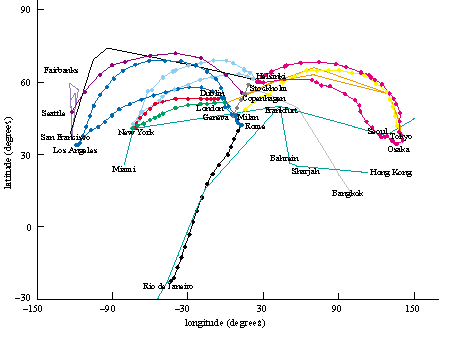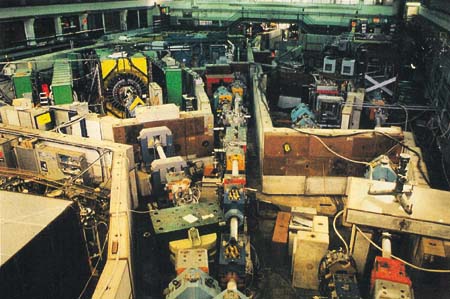International airlines are collaborating with physicists to assess whether aircrew are at risk from cosmic radiation as routine monitoring will soon become mandatory.

When Victor Hess discovered cosmic radiation almost 90 years ago, he did so in manned balloon flights that reached altitudes of up to 5 km in the Earth’s atmosphere. This was only a few years after the Wright brothers’ first flight and neither they nor Hess are likely to have thought that, by the year 2000, millions of air passengers and crew would be travelling through this complicated radiation field each year. Research outside the Earth’s atmosphere has resulted in a comprehensive understanding of the various types of electromagnetic radiation and particles that make up cosmic rays. More recently, an international team of physicists has joined forces with NASA and several European airlines to study in detail how the radiation field varies inside the atmosphere depending on the altitude, latitude and solar activity (see link).
Astronauts are subjected to the full intensity of high-energy cosmic rays and solar particles (together with the secondary particles produced in the spacecraft walls), and the biological risks in space are the subject of ongoing investigations. A typical return mission to Mars, for example, could result in a total “dose equivalent” of up to 0.5 sievert. The dose equivalent takes into account the harm caused by a particular type of radiation. Current estimates suggest that a person who receives a 1-4 sievert dose of ionizing radiation incurs a few per cent increase in the risk of contracting fatal cancer in his or her lifetime, although the risk level depends on sex and age.
The radiation we observe at aircraft altitudes of typically 10-12 km is due to very high-energy particles – mainly protons and helium nuclei, together with a small amount of heavy nuclei – penetrating the atmosphere and colliding with air atoms. These collisions give rise to the production of more particles, such as protons, neutrons and various mesons. A cascade of particles is then produced by successive interactions as they penetrate deeper into the atmosphere. As a result, the flux of particles increases in the upper atmosphere and reaches a maximum at about 20 km above sea level. Below this point, the number of particles decreases due to energy losses and various particle interactions.
Happily, at the Earth’s surface we are protected by the air above us, which provides the same degree of shielding as a layer of water 10 m thick. The small amount of radiation that eventually reaches us in the form of muons and electrons makes up about 10% of the natural background at sea level.
The need to monitor cosmic rays
Several studies of cosmic rays in the Earth’s atmosphere have been undertaken intermittently during the last few decades. However, cosmic-ray physicists regard the atmosphere as a nuisance because it causes fragmentation and energy losses that largely destroy the information on element abundances and energy spectra of interest to them.
Some years ago, the European Union expressed concern at the patchy knowledge available on the radiation field at aircraft altitudes. It funded a major investigation during the last minimum in solar activity between 1995 and 1998. These investigations have recently received further significant support and a major European study will be continued through the solar maximum between 2000 and 2003. The research team includes physicists from my group at the Dublin Institute for Advanced Studies in Ireland – the main interest of which is cosmic-ray astrophysics – and the leading radiological research centres in Italy, Austria, Germany, France, the UK and Sweden.
But why the sudden interest in the situation now? After all, we have been travelling at altitudes up to 17 km for decades, and few of us seem to care about being bombarded by high-energy particles. One of the main reasons is concern that the relative biological damage caused by neutrons may have been underestimated in the past. In addition, there is an increasing trend for subsonic aircraft to fly at higher cruising altitudes. And the International Commission on Radiological Protection (ICRP) has recently made a series of recommendations concerning exposure to cosmic rays.
Neutrons are the major source of concern because they occur in significant numbers at aircraft altitudes. An improved understanding of their role in the radiation field is therefore important. Following the ICRP recommendations, the European Union has revised its basic safety-standards directive to include, for the first time, exposure to naturally occurring sources of ionizing radiation – including cosmic radiation – as an occupational hazard. The revised directive is being incorporated into the laws of the EU member states this month, and monitoring of aircrew will soon become mandatory.
Results and regulations
The problems involved in monitoring cosmic radiation at high altitudes are quite different from those encountered at sea level by, for example, the nuclear industry. The wide range of particles and the very different energy regime – the energy can be thousands of times greater than at sea level – demand a special approach.
The research team has developed several different types of detector for the project, some of which have operated at high altitude on the Zugspitze mountain in Germany and Chacaltaya in Bolivia. Many detectors have flown on planes going from Europe to the US, Asia and South America (see figure 1). The airline partners – Alitalia, Aer Lingus, British Airways, Finnair, Lufthansa and Scandinavian Airlines – together with NASA, all provided special facilities for the detectors on their flights.
In addition, the detectors were placed in high-energy beams at particle accelerators at Uppsala University in Sweden, the GSI laboratory in Germany and at CERN in Switzerland. At the super proton synchrotron at CERN, for example, we can simulate the radiation field at an altitude of about 12 km using the interactions of 120 GeV c-1 or 205 GeV c-1 protons and pions with a copper target (figure 2). This facility enables us to calibrate all the instruments together, and greatly enhances the quality of the data, even when the instruments cannot be housed on the same flight. Further instrument-response studies and calibrations are performed with neutron and heavy-ion beams. In addition, computer programs have been extended to provide a better description of the transport of cosmic rays, and a new code based largely on experimental data is being developed.
The results obtained so far provide a fairly comprehensive picture of the expected dose rates, at least for much of the northern hemisphere. Overall, the dose-equivalent rates vary from about 1 to 17 microsieverts per hour. The highest value recorded was at an altitude of 22 km during a NASA flight. These rates were recorded during a lull in solar activity, when we expect the intensity of galactic cosmic rays to be highest.
The new EU regulations propose that there should be individual estimates for aircrew whose annual doses fall in the 1-6 millisievert per year category, and that pregnant aircrew should not be exposed to more than 1 millisievert per year. These estimates could be made for various routes using improved computer codes that are based on measured radiation levels and occasional experimental data. Currently, the crews of subsonic commercial aircraft fly at altitude for up to 600 hours or so each year. Supersonic crews fly for about half this time. Our results suggest that a crew member will receive a dose equivalent greater than 6 millisievert per year only in exceptional cases.
This work has also allowed us to investigate in detail the physics of cosmic-ray interactions in the atmosphere. For instance, we have found that the neutron spectrum – the number of neutrons as a function of energy – has two peaks. One peak is at about 1 MeV and is caused by nuclear evaporation. The second peak, at around 100 MeV or higher, arises because few neutrons interact in this energy region and thus survive.
We have also determined dose rates as a function of altitude and latitude, and the spectra of primary and secondary nuclei – from helium up to iron – at subsonic and supersonic altitudes. We have also improved the methods for routine dose assessment.
Currently, we are entering a period of maximum solar activity. During this phase we expect to complete our studies for the full 11 year solar cycle. And we should detect several instances when high-energy particles are ejected by the Sun. Such events will be superimposed on the normal galactic cosmic-ray intensity, which has varied little over the last few million years.
For a given altitude and latitude, the variations caused by solar phenomena are unpredictable. Ground-monitoring and space-weather systems will be used as an early-warning system, giving us time to deploy our detectors at high altitudes and plug a gap in our understanding of solar cosmic rays.




